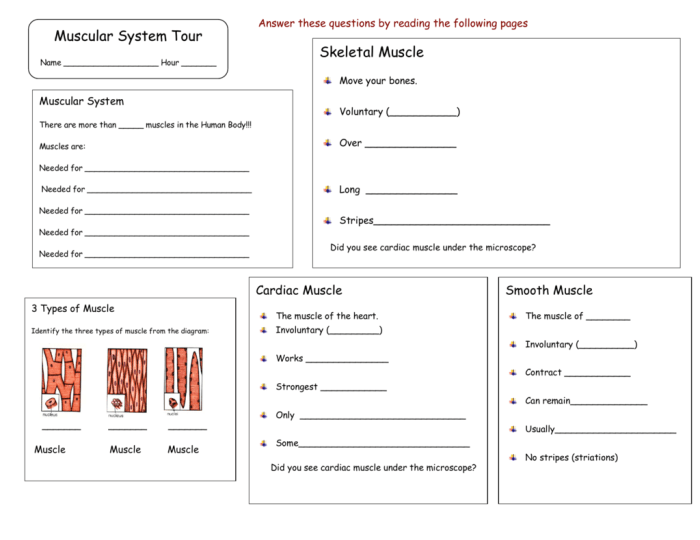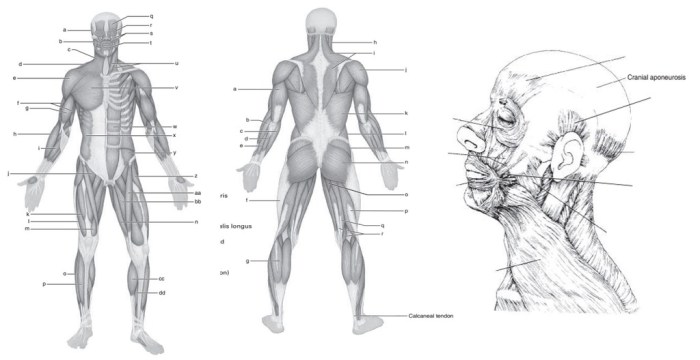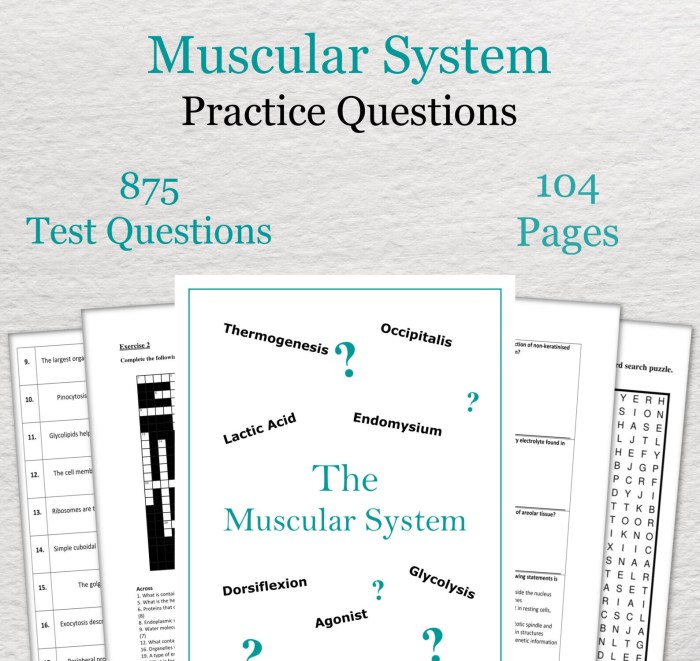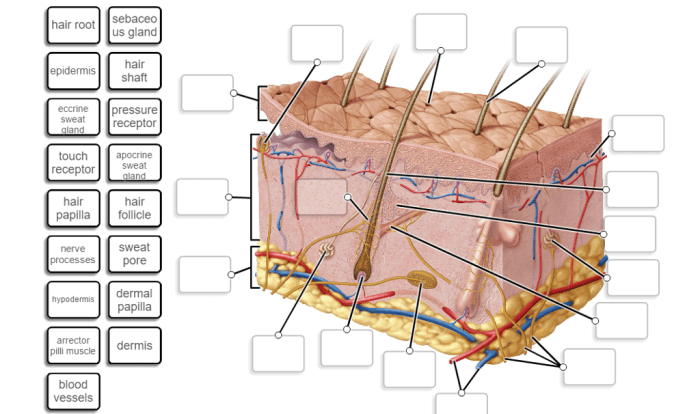Gross anatomy of the muscular system answer key – The gross anatomy of the muscular system is a fascinating field of study that provides a comprehensive understanding of the structure and function of the muscles. This answer key delves into the intricacies of the muscular system, offering a thorough examination of the various muscle groups and their roles in human movement and function.
Throughout this guide, we will explore the muscles of the head and neck, trunk, upper limbs, and lower limbs, examining their origins, insertions, innervations, and actions. We will also discuss the significance of fascia and tendons in the muscular system and explore the clinical applications of gross anatomy in medical practice.
Introduction to the Gross Anatomy of the Muscular System
Understanding the gross anatomy of the muscular system is crucial for comprehending the body’s movement and function. Muscles, the primary components of this system, enable voluntary and involuntary movements, maintain posture, and generate heat. There are three main types of muscles: skeletal, smooth, and cardiac.
Muscles of the Head and Neck
The head and neck region encompasses a complex array of muscles responsible for facial expressions, mastication, and neck movements. Muscles of the face, such as the orbicularis oculi and zygomaticus major, facilitate facial expressions. Muscles of mastication, including the masseter and temporalis, are involved in chewing.
Neck muscles, like the sternocleidomastoid and trapezius, control head and neck movements.
Muscles of the Trunk

| Region | Muscle | Origin | Insertion | Innervation | Actions |
|---|---|---|---|---|---|
| Back | Trapezius | Occipital bone, spinous processes of cervical and thoracic vertebrae | Clavicle, acromion, spine of scapula | Spinal accessory nerve (XI) | Elevation and retraction of scapula, extension and rotation of head |
| Chest | Pectoralis major | Clavicle, sternum | Humerus | Pectoral nerves (C5-T1) | Flexion, adduction, and medial rotation of arm |
| Abdomen | Rectus abdominis | Pubic bone, pubic crest | Xiphoid process, costal cartilages | Thoracoabdominal nerves (T7-L1) | Flexion of trunk |
| Pelvis | Gluteus maximus | Ilium, sacrum, coccyx | Gluteal tuberosity of femur | Inferior gluteal nerve (L5-S2) | Extension, external rotation, and abduction of hip |
Muscles of the Upper Limb: Gross Anatomy Of The Muscular System Answer Key
- Shoulder:Deltoid, supraspinatus, infraspinatus, teres minor
- Arm:Biceps brachii, triceps brachii, brachialis
- Forearm:Flexor carpi radialis, extensor carpi ulnaris, pronator teres
- Hand:Thenar muscles (abductor pollicis brevis, opponens pollicis), hypothenar muscles (abductor digiti minimi, opponens digiti minimi)
Muscles of the Lower Limb
| Region | Muscle | Origin | Insertion | Innervation | Actions |
|---|---|---|---|---|---|
| Hip | Iliopsoas | Ilium, psoas major | Lesser trochanter of femur | Femoral nerve (L2-L4) | Flexion and external rotation of hip |
| Thigh | Quadriceps femoris (vastus lateralis, vastus medialis, vastus intermedius, rectus femoris) | Femur | Tibia, patella | Femoral nerve (L2-L4) | Extension of knee |
| Leg | Gastrocnemius | Femur, tibia | Calcaneus | Tibial nerve (L4-S2) | Plantar flexion of foot |
| Foot | Tibialis anterior | Tibia, fibula | Medial cuneiform, base of first metatarsal | Deep peroneal nerve (L4-S1) | Dorsiflexion and inversion of foot |
Fascia and Tendons

Fascia, a connective tissue network, surrounds and supports muscles, providing structural stability and reducing friction during movement. Tendons, specialized connective tissue cords, connect muscles to bones, transmitting the force generated by muscle contractions to the skeletal system.
Clinical Applications

Knowledge of gross anatomy is essential in clinical practice for:
- Diagnosing and treating musculoskeletal disorders (e.g., strains, sprains, fractures)
- Planning surgical interventions (e.g., muscle repair, tendon transfer)
- Developing rehabilitation programs (e.g., exercises to strengthen weakened muscles)
FAQ Compilation
What is the significance of understanding the gross anatomy of the muscular system?
Understanding the gross anatomy of the muscular system is essential for comprehending human movement, posture, and physical function. It provides a foundation for diagnosing and treating musculoskeletal disorders and injuries.
How many types of muscles are there?
There are three main types of muscles: skeletal muscles, smooth muscles, and cardiac muscles. Skeletal muscles are attached to bones and responsible for voluntary movement, smooth muscles are found in internal organs and blood vessels, and cardiac muscles are found in the heart.
